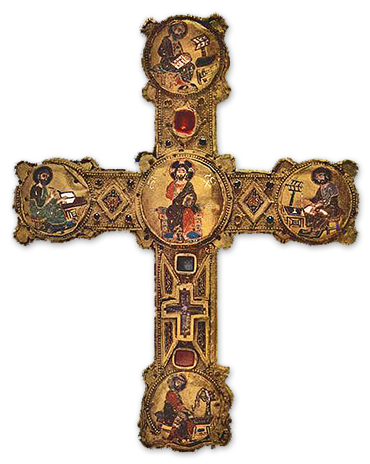
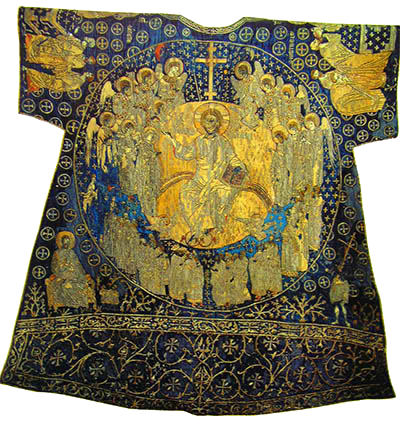
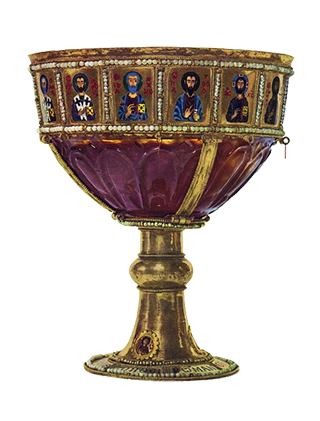
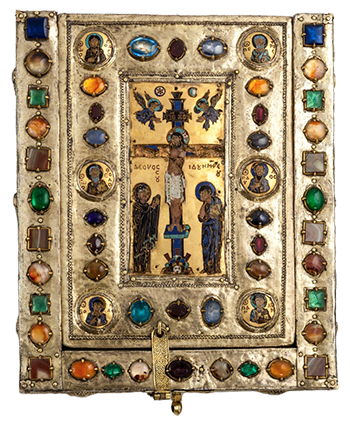
![]()
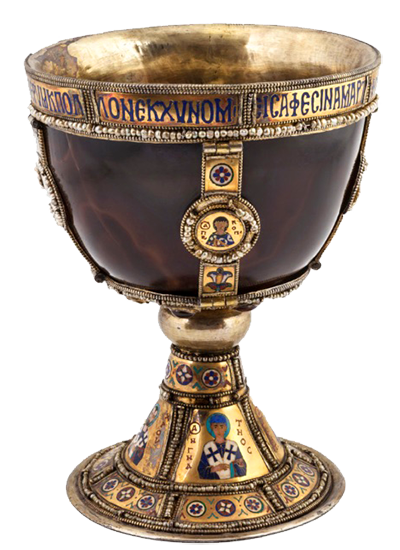
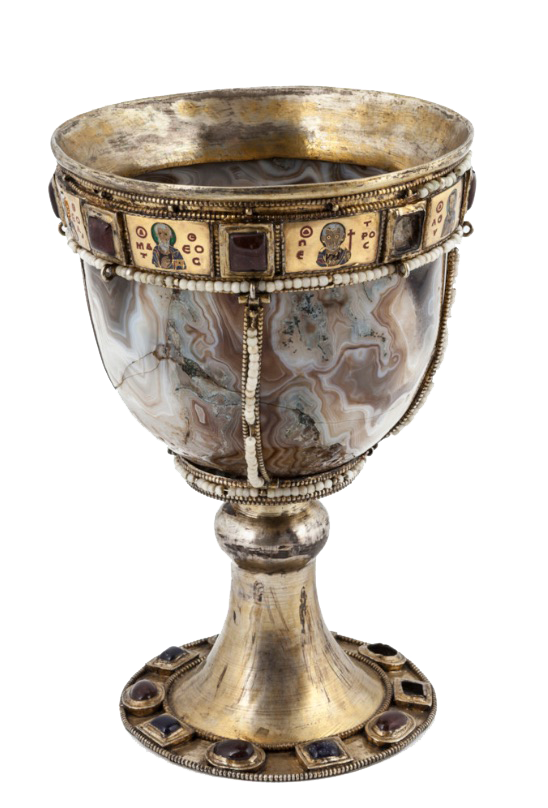
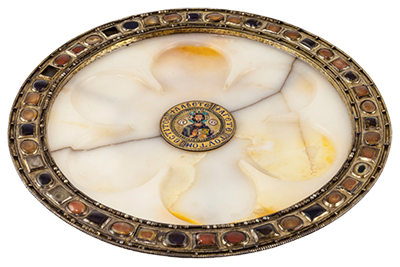
![]()
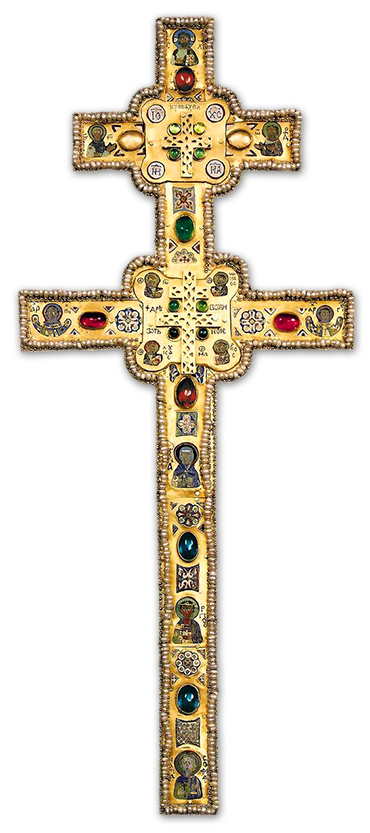
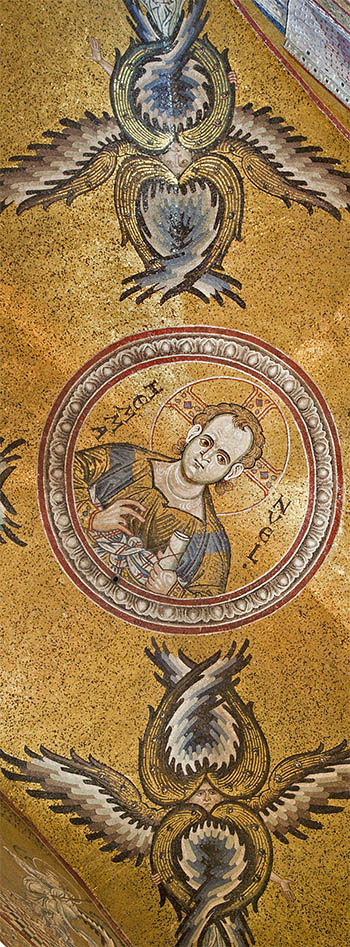
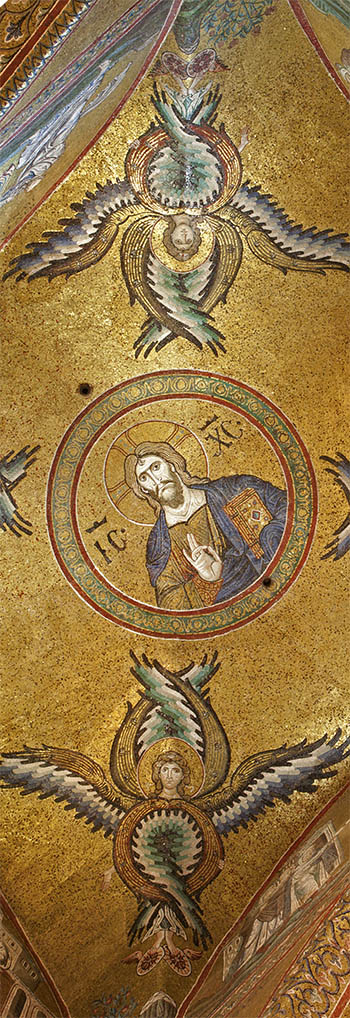

Church of the Archangel Michael - the Archistrategos - in Chonai
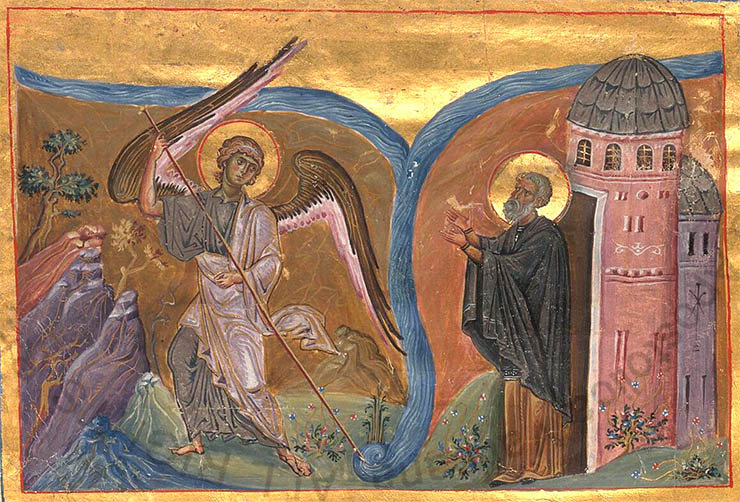
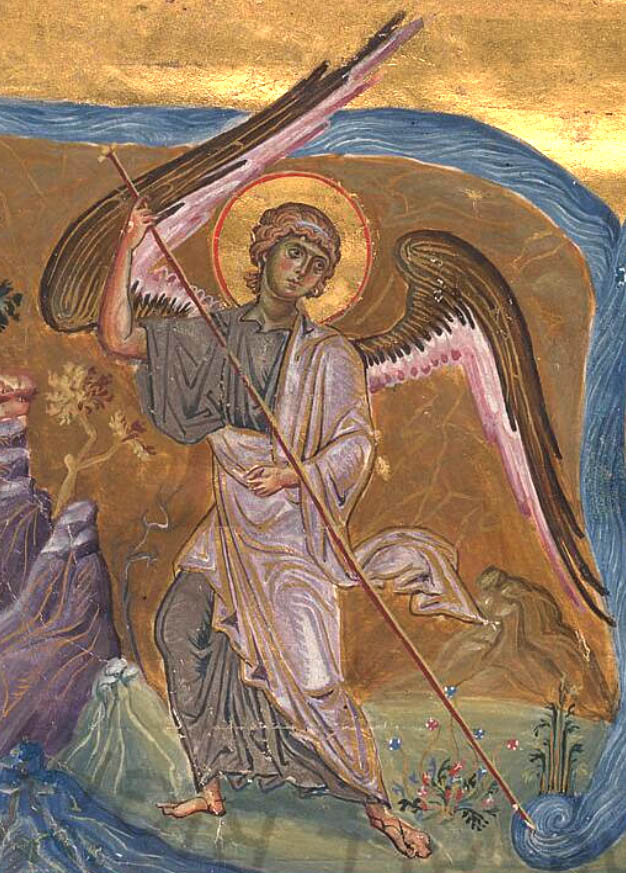 Niketas Choniates, the author of "O City of Byzantium" a chronicle of the history of the 11th and 12th centuries, was born in the provincial town of Chonai, present-day Khonas, near ancient Collosae in Phrygia Pacatiana. Chonai was renowned for its Church of the Archangel Michael and for the miracle attached to it. In the story of the "Miracle of Chonai" the pagans, intent on destroying this beacon of Christianity, diverted the river in order to flood the building. The Archangel Michael, however, saved his church by striking with his staff the rock on which it had been erected, and miraculously a funnel or tunnel was bored through which the river's waters flowed safely; from the Greek word for funnel, chone, the town took its new name.
Niketas Choniates, the author of "O City of Byzantium" a chronicle of the history of the 11th and 12th centuries, was born in the provincial town of Chonai, present-day Khonas, near ancient Collosae in Phrygia Pacatiana. Chonai was renowned for its Church of the Archangel Michael and for the miracle attached to it. In the story of the "Miracle of Chonai" the pagans, intent on destroying this beacon of Christianity, diverted the river in order to flood the building. The Archangel Michael, however, saved his church by striking with his staff the rock on which it had been erected, and miraculously a funnel or tunnel was bored through which the river's waters flowed safely; from the Greek word for funnel, chone, the town took its new name.
In the 12th century Chonai was a vibrant and prosperous town with 10 churches. It was the location of an annual fair on September 6th associated with the great shrine of the Archangel Michael and primary destination of pilgrimage in the Byzantine Empire. The church was the location of medicinal springs and Michael was believed to perform miracles for pilgrims who called upon him for help. Such was the power of the archangel that people sent donations from across the empire to thank him for his help. Offerings also came in from long distances. Clive Foss in his article "Pilgrimage in Medieval Asia Minor" tells us: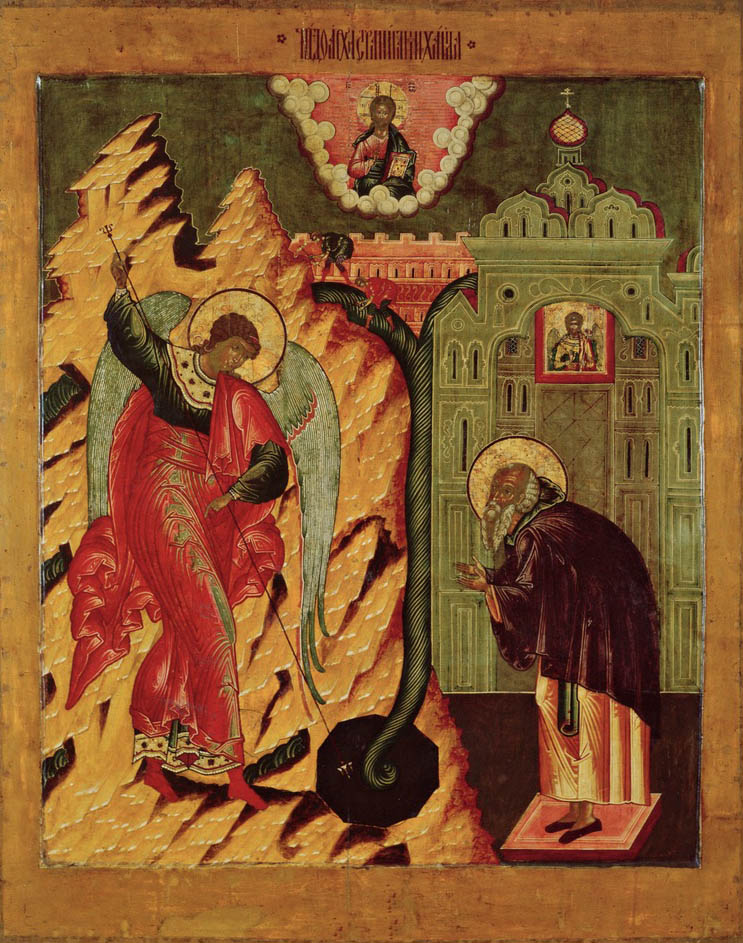
"In some cases, natural objects witnessed the divine power. Chonai was renowned as the place where St. Michael had cleft a mountain to divert a river and created a healing spring... Offerings also came in from long distances. Chonai was the goal of a young man named Manuel who was entrusted with the offerings of the village of Didia near Gangra in Paphlagonia, which amounted to a whole pound of gold. He came on foot and was almost murdered for his money. St. George rescued him, though, and the Archangel received the gold.... In the late twelfth century, the fair at Chonai was attracting huge crowds from all the neighboring cities and provinces and even from the “barbarian Ikonians”—the Seljuk Turks of Konya—who came to buy and sell. "
The church also had a miraculous icon of Michael. It is shown inside the church in some icons and frescos showing the church. You can see an example above from a Russian icon. Above the monk you can see into the church and the winged image of the angel dressed in red.
It was a frontal icon and would have looked close to this one looted from Constantinople during the Fourth Crusade:
![]()
It must have been a large domed church - we can see the dome in this famous icon of the miracle. No firm remains of the church have been identified, despite its size and magnificence:
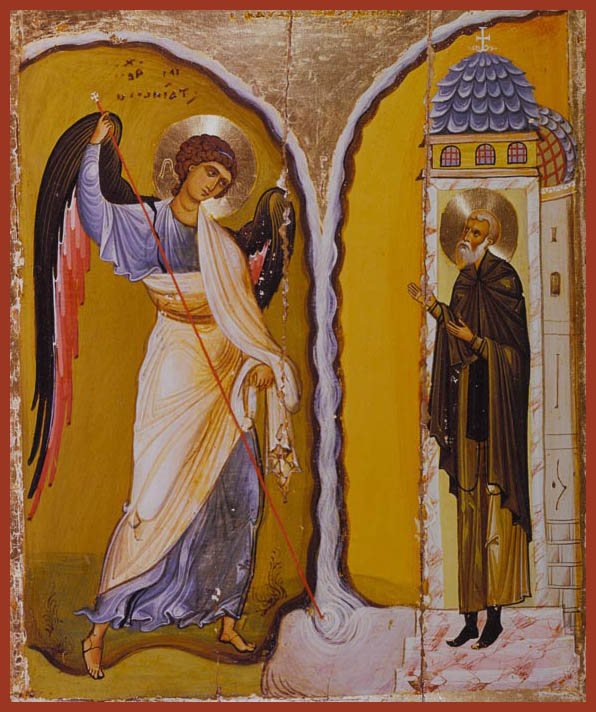
In his letter to the Collosians Saint Paul warned the local Christian community there against the worship of angels. This was because the worship of the Anatolian god Min, one of the oldest Indo-European cults associated with lighting,thunder and loud noises on mountain tops, had been long established there localized in local healing springs. In Greco-Roman times this god was sometimes depicted as a young man with curls, which obviously resembles icons of the Archangel. This is probably accidental. Saint Paul recognized the active role of angels in the lives of Christians - especially his own - but reserved worship to God alone. Paul and Peter had both had miraculous rescues at the hands of angels in bodily form. After the ascent of Christ angels were the only physical expressions of God's power on earth, including the Holy Spirit. We can also remember how the angel physically appeared at the tomb of Christ after his resurrection.
The Apostles John and Phillip, eager to promote the churches of Ephesus and Collossea, believed the local worship by pagan of angels as wrong, but the presence of Michael in the springs was without doubt, it was simply attributed to the wrong spiritual being. Therefore, Christian veneration for Michael as the earthly manifestation of the Christian God's power and ability to perform miracles.
This is the story of the miracle of the Archangel Michael at Chonae, as told in the earliest extant version, a pilgrim tale from around the year 1000 refined by Simeon Metaphrastes. The original story dates back to the sixth century:
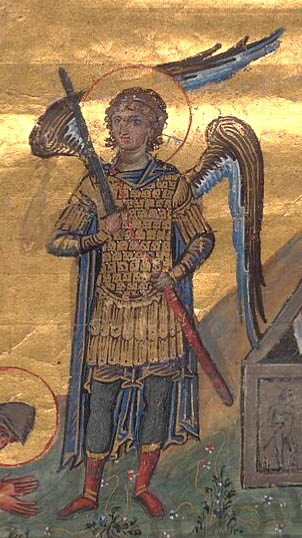 "Near Hierapolis, in Phrygia, there was a place called Chonae ("plunging''), and in that place there was a spring of miraculous water. When Apostle John the Theologian, accompanied by Philip, preached the Gospel in Hierapolis, he looked upon that place and prophesied that a spring of miraculous water would open up there, from which many would receive healing, and that the great Archangel of God Michael would visit that place. Soon afterward, this prophecy was fulfilled: a spring of water burst forth and became widely known for its miraculous power. A pagan in Laodicea had a daughter who was mute, which caused him great sorrow. Archangel Michael appeared to him in a dream, and told him to take his daughter to the spring, where she would be cured. The father immediately obeyed, brought his daughter to the spring, and found many people there seeking deliverance from various infirmities. These people were all Christians. The man asked how he should seek healing, and the Christians told him: ``You must pray to the Archangel Michael, in the name of the Father and of the Son and of the Holy Spirit.'' The man prayed in this way, gave his daughter a drink of this water, and the girl began to speak. The pagan, his daughter and his whole household were baptized. He also built a church over the spring dedicated to the Archangel Michael. Later, a young man named Archippus settled there and lived a life of austerity, in fasting and prayer.
"Near Hierapolis, in Phrygia, there was a place called Chonae ("plunging''), and in that place there was a spring of miraculous water. When Apostle John the Theologian, accompanied by Philip, preached the Gospel in Hierapolis, he looked upon that place and prophesied that a spring of miraculous water would open up there, from which many would receive healing, and that the great Archangel of God Michael would visit that place. Soon afterward, this prophecy was fulfilled: a spring of water burst forth and became widely known for its miraculous power. A pagan in Laodicea had a daughter who was mute, which caused him great sorrow. Archangel Michael appeared to him in a dream, and told him to take his daughter to the spring, where she would be cured. The father immediately obeyed, brought his daughter to the spring, and found many people there seeking deliverance from various infirmities. These people were all Christians. The man asked how he should seek healing, and the Christians told him: ``You must pray to the Archangel Michael, in the name of the Father and of the Son and of the Holy Spirit.'' The man prayed in this way, gave his daughter a drink of this water, and the girl began to speak. The pagan, his daughter and his whole household were baptized. He also built a church over the spring dedicated to the Archangel Michael. Later, a young man named Archippus settled there and lived a life of austerity, in fasting and prayer.
The pagans did many malicious things to Archippus, for they did not like the fact that this Christian holy place emanated such spiritual power and attracted so many people to it. The pagans, in their wickedness, rerouted the nearest river in order to flood the church and the spring. By the prayers of Archippus, the holy Archangel Michael opened a fissure in the rock beside the church, and the river's water plunged into it. This is how that place was saved and why it was called Chonae, or `"of the plunging,'' for the river's water that plunged into the open fissure. St. Archippus labored in asceticism there until the age of seventy, and peacefully reposed in the Lord."
Although Chonai was the seat of an archbishopric in the ninth century, it began to decline during the Seljuk occupation of 19 years which followed the debacle of Manzikert in 1071; the Seljuks were evicted only in 1090. The Seljuks were determined to evict the entire Christian population from Asia Minor and repopulate it with Muslim nomads. The Greeks were farmers, fishers, grape growers who were attached to the land and nurtured its prosperity. Turkish nomads destroyed the farmlands and uprooted the local inhabitants.
In the twelfth century, Chonai was a frontier town through which Byzantine armies on campaign frequently passed. Crusading armies also passed this way.
In 1143 a new bishop from Constantinople, a eunuch named Niketas, arrived from Constantinople. On of his first acts was to welcome Manuel Komnenos who was on his way from Syria to Constantinople to be crowned passing through Chonai. Nicetas delivered a prophecy that Manuel was chosen by God to rule and would be crowned in Hagia Sophia, displacing his older brother, Isaac who should have been emperor before him.
His next act was to repair and refurbish the Church of the Archangel, where the prophecy occurred as Manuel was attending the liturgy. He was able to do this using the funds of the diocese and donations from his rich court official contacts back in Constantinople. Niketas deplored the moral degradation he found in his flock. He realized that the local people would respect his moral authority if he stood up for them in disputes over property and land. Therefore, he took land from the rich and gave it to the poor.
Once when Bishop Niketas was on his way to Lydia on state business he and his traveling companions were attacked by Turkish band of robbers. Miraculously they not only let them go, they let them keep their mules. The citizens of Chonai were not surprised, they believed Niketas's prayers and the intervention of the Archangel Michael was still delivering them from the Turks:
"The town was almost the only place that remained uncaptured by the Turks. For they failed to overrun the whole of Asia only to the extent that they were unable to despoil Chonai; as long as it was fortified by the wall of his presence. For that nation, bursting forth from high in the east, flooded everything, but this town alone remained above water, since it had the most perfect Noah securing it inside and out."
Bishop Niketas not only prayed for the delivery of Chonai from the Turks, his prayers save local farmers from locusts and the drought. On top of that he was believed to have the gift of prophecy.
The end of the reign of Manuel I saw the disaster of the battle of Myriokephalon in 1176 - a clear signal that, regardless of the efforts of valiant Christian solders like Manuel, the end of the Byzantium in Asia Minor would be unavoidable. Many insurrections followed which wracked Anatolia under the Angelos emperors which did not leave Chonai untouched. In 1189 the city was overrun by the rebel Theodore Mangaphas, and the Church of the Archangel was put to the torch. In 1191-92 the first false-Alexios - pretenders who claimed to be Manuel's dead son - allowed the altar, pulpit, and mosaic icons to be profaned and destroyed by his Turkish troops. This was a great shock to the Byzantine world and brought deep despair to the citizens of Chonae. It must have seemed like the end of the Christian church was at hand in the very heart where it had been founded in the days of the apostles.
After staying with Manuel I in Constantinople, Louis VII of France, en route to the Holy Land as part of the Second Crusade, was attacked here by the Turks in the battle of Mount Cadmus of 1148. He was accompanied by his young wife, Eleanor of Acquitaine.
It must have been with some bitterness that Niketas Choniates beheld Emperor Theodore I Laskaris ceding Chonai at the beginning of 1206 to Manuel Mavrozomes, the father-in-law of the sultan of Ikonion. The Byzantines regained Chonai in 1258 during the reign of Theodore II, but shortly thereafter it fell to Turkish rule once again and degenerated into an insignificant village. Until 1924 the inhabitants - 400 Christian families - were Greeks who spoke only Turkish.
The growth in the population of western Asia Minor and the wealth of the region led to blossoming of cities like Chonai. The number of merchants attending local fairs and selling their wares jumped. While in Chonai traveling merchants bought local goods to sell elsewhere, they also made loans. Fairs like this were usually associated with carnivals. In Byzantium these events invited vices like prostitution and gambling.
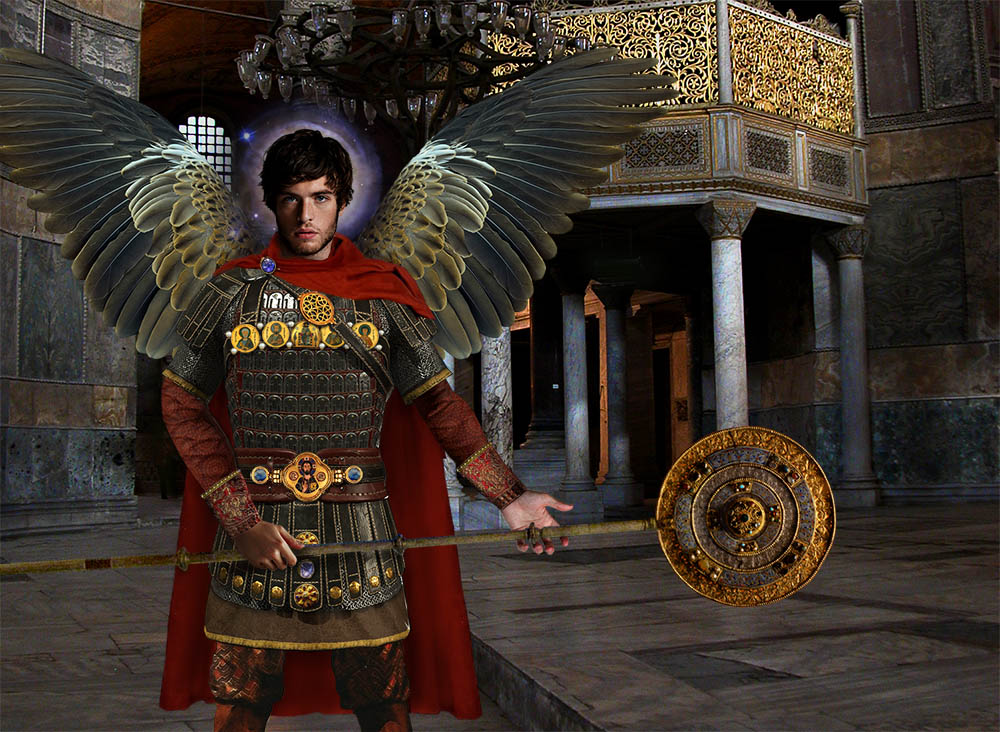 Feeling more secure people began to move from shrine and church to church in much larger numbers. People spread tales and stories by word of mouth. Prophecy was associated with the city of Chonai in the 12th century and was centered on the Church of the Archangel Michael. When John II Komnenos needed to justify his choice of his youngest son as his successor, he referred to the predictions and prophecies of "men beloved of God" that God had destined Manuel to become emperor. The historian's godfather and namesake, Niketas, the bishop of Chonai, prophesied that Manuel I's older brother, Isaakios, would submit to him as emperor, and that Manuel would outlive his grandfather Alexios I, but that at the end of his life he would go mad. All if this came true.
Feeling more secure people began to move from shrine and church to church in much larger numbers. People spread tales and stories by word of mouth. Prophecy was associated with the city of Chonai in the 12th century and was centered on the Church of the Archangel Michael. When John II Komnenos needed to justify his choice of his youngest son as his successor, he referred to the predictions and prophecies of "men beloved of God" that God had destined Manuel to become emperor. The historian's godfather and namesake, Niketas, the bishop of Chonai, prophesied that Manuel I's older brother, Isaakios, would submit to him as emperor, and that Manuel would outlive his grandfather Alexios I, but that at the end of his life he would go mad. All if this came true.
Patriarch Dositheos predicted that Isaakios II would ascend the throne. Andronikos's partisans believed the prophecy that he would become emperor. The deluded Isaakios II believed the predictions that he would unite in his person both East and West, that his eyesight would be restored and his gout cured by miracle, and that he would be transformed into a godlike man. Patriarch Dositheos prophesied that all kingdoms should submit to him.
Nicetas Choniates, a relative of bishop Niketas mentioned erlier, relates the following from his book:
"The emperor set out from the queen of cities [summer 1176], passing through both Phrygia and Laodikeia, and came to Chonai, a prosperous and great city, the ancient Colossae, this author's homeland. He entered the enormous Church of the Archangel, incomparable in beauty and a marvel of craftsmanship, and then marched on to Lampe and the city of Kelainai, where are the headwaters of the Maeander and where the Marsyas River discharges into the Maeander;
"From there he went on through Choma, halting at the ancient abandoned fortress of Myriokephalon, so called, I believe, either because of what had happened or as a prediction of what was to occur; for at this place many tens of thousands of Roman heads would fall in violent death, as I shall relate."
'My kinsman, enrolled in the clergy of the city of Chonai, a Levite in rank [deacon], and a man of great courage who accompanied the remainder of the army to Charax in military attire, looted whatever he could get his hands on in the Turkish tents. Even in the face of danger he did not leave the spoils behind but carried away such loot as Turkish garments in a pouch and a thick-fleeced ewe. As he walked slowly with all eyes turned on him, he was applauded by some as being fearless in perilous times and the very best of those who campaigned at that time, but others derided him for sparing the life of a sheep. He made his way in this fashion, reproaching when it was practicable the runaways who took flight while no one was pursuing them [1177-79]."
"I must not neglect to record another noteworthy event. There was a certain eunuch by the name of Niketas who presided as bishop over the city of Chonai and who was the habitation of every virtue; indeed, such were his oracular powers, his ability to foresee the future, that he was reckoned as one of the greatest of seers and deemed a marvel by those who knew him. While ours was a wicked and adulterous generation, we were fortunate to have such a good man. When the emperor [Manuel], newly crowned as successor to his father's throne, passed through Chonai on his way from Armenia and entered the Church of the Archangel [Michael], he had been blessed by the hand of this bishop. The latter was celebrated because of his virtue and his fame was spread far and wide. The clergy and of these the most astute doubted whether Manuel, a mere youth with the first growth of down on his cheeks, would really be able to govern the empire, which very much needed a man with shaggy beard, grown hoary in prudence, and, moreover, whether he could overthrow his brother Isaakios, who had a more lawful claim to the throne and was ensconced in the queen of cities. This great man, truly a man of God, resolved the question and answered their doubts: "Yes, this lad shall govern the empire and his brother shall submit to him, for thus has God ordained and decreed. You may even know those things about which you have not inquired, that he shall outlive his own grandfather, I speak of his forefather Alexios, the emperor of the Romans, by a few years, and when his end approaches he will go mad..."
"In this way did this fellow receive his just dues for the crimes he wrongfully committed. When he armed Turks against Romans and inflamed those who came streaming in to him against his own countrymen, the wretch damaged the celebrated Church of Michael, the commander-in-chief of the divine and incorporeal hosts, in my city of Chonai; he defiled the all-hallowed tabernacle of God by entering with Turks, and before his very eyes the accursed man tolerated the destruction of the multicolored representations of Christ and the saints, the smashing by ax and stonecutter's tool of the holy pulpit, and the desecration and dashing to the earth of the all-hallowed table of offerings."
Chonai, the modern city of Honas in Turkey, prospered from the traffic passing through from Ikonion to the Maeander River valley; fish abounded in the river and lakes, and the valley provided liquorice, cardamum, myrtle, figs, grapes, and pomegranates. Today it is famous for its cherries.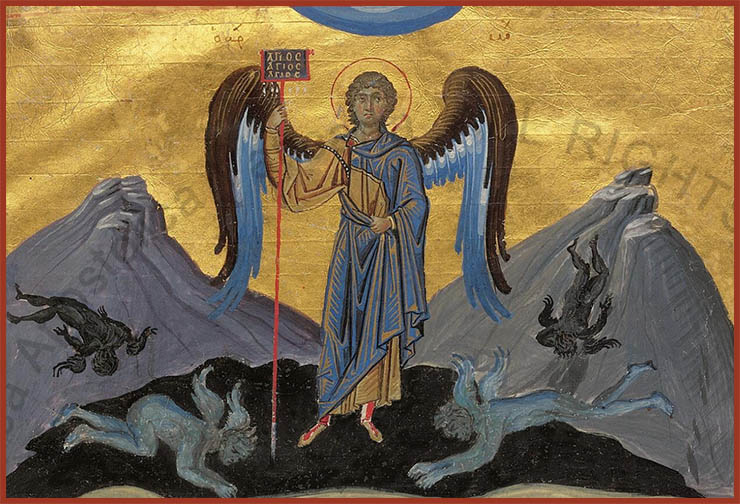 The Archangel Michael defeats two devils and two others fall down powerless below him. This miniature is also from the Imperial Menologion of Basil II.
The Archangel Michael defeats two devils and two others fall down powerless below him. This miniature is also from the Imperial Menologion of Basil II.
Apolytikion of Miracle of Michael in Colossae
Fourth Tone
O Commanders of the Heavenly Host, we the unworthy beseech you, that through your entreaties you will fortify us, guarding us in the shelter of the wings of your ethereal glory, even as we fervently bow before you crying: "Deliver us from all danger, as Commanders of the Powers on high! "
Kontakion of Miracle of Michael in Colossae
Second Tone
O Michael, who standest altogether radiant before the Trinity together with all the heavenly Hosts, and with them dost cry aloud the song inspired of God: As thou dost pass throughout the earth by God's command and art made wondrous with exceedingly great marvels, cease not to intercede for us all.

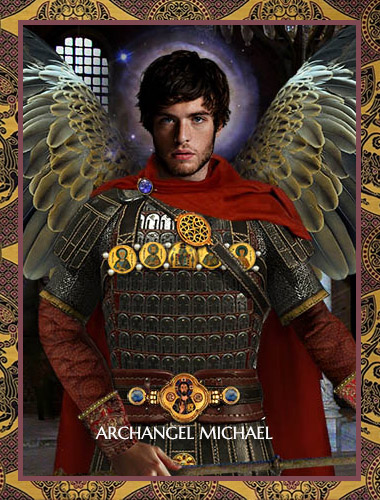


 click here for icons of christ
click here for icons of christ click here for icons of the theotokos
click here for icons of the theotokos click here for icons of angels
click here for icons of angels click here for icons of saints
click here for icons of saints








